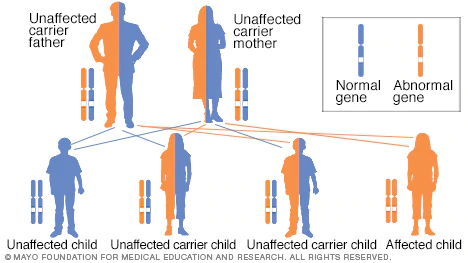Autosomal Recessive Inheritance
Introduction
 Image courtesy of MAYO CLINIC Opens in new window
Image courtesy of MAYO CLINIC Opens in new windowAutosomal recessive disease Opens in new window occurs only in homozygotes, individuals with two mutant alleles and no normal allele, because in these diseases, with only one of a pair of alleles functioning and the other (abnormal) allele not, can typically compensate to carry out the enzymatic reaction required for normal physiological function, thereby preventing disease.
In autosomal recessive inheritance, a trait governed by a recessive allele is expressed only when the homozygous condition exists. In order for an individual to demonstrate the trait or disorder, both parents must carry the recessive allele.
If an affected person reproduces with a homozygous unaffected person, their children will be heterozygous for the trait and will not manifest the disease, but they will be carriers.
If two carriers reproduce, then the probability (for each pregnancy) is about 25% that the child will manifest the disease, 50% that the child will be a carrier, and 25% that the child will neither have the disease nor be a carrier. Usually an affected child is the offspring of two heterozygotes who are themselves normal.
Disorders transmitted by recessive inheritance often involve altered enzymes. Normally only 50% of the normal amount of these enzymes is sufficient for normal function. Examples of autosomal recessive disorders include cystic fibrosis Opens in new window, phenylketonuria (PKU), hypothyroidism, Tay-Sachs disease Opens in new window, congenital adrenal hyperplasia, and galactosemia. Hemoglobinopathies such as sickle cell disease Opens in new window are also transmitted by autosomal recessive inheritance. Characteristics of disorders inherited by autosomal recessive inheritance are listed in below.
Major Characteristics of Autosomal Recessive Inheritance & Disorders
- The mutant gene is located on an autosome.
- Two copies of the mutant gene are needed for phenotypic manifestations.
- Males and females are affected in equal numbers, on average.
- There is usually no sex difference in clinical manifestations.
- Affected individual receives one mutant gene from each parent.
- Family history is usually negative, especially for vertical transmission (in more than one generation).
- Other affected individuals in family in same generation (horizontal transmission) may be seen.
- Consanguinity is present more often than in other modes of inheritance.
- Fresh gene mutation is rare.
- Age of disease onset is early newborn, infancy, and early childhood.
- Often involves enzyme defect or deficiency.
- Disease course is usually severe.
New Mutation in Autosomal Recessive Disorders
When a child is affected with an autosomal recessive condition, the assumption is generally made that both parents are heterozygous carriers for the condition. Yet, new mutations occur all the time during the generation of gametes.
Might not an individual have two mutant alleles for an autosomal recessive condition by virtue of inheriting one mutant allele from a carrier parent that came from a parent who was not a carrier?
Such a situation is, of course, not impossible but is relatively unlikely compared with the situation in which both parents are heterozygous carriers. This is because the chance that the gamete from a noncarrier parent had acquired a mutant allele by spontaneous mutation ranges from 1 in 105 to 1 in 106, which is thousands of times less likely than the typical 1 in 20 to 1 in 1000 chance that the gamete contained the mutant allele because the parent is a heterozygous carrier.
The relative unimportance of new mutations in autosomal recessive disease is in stark contrast to the situation with dominant and X-linked disorders.
See also:
- Adapted from Lashley, F.R. (1998). Clinical genetics in nursing practice (2nd ed.). New York. Springer.

